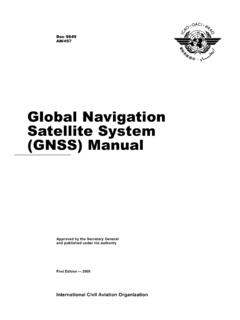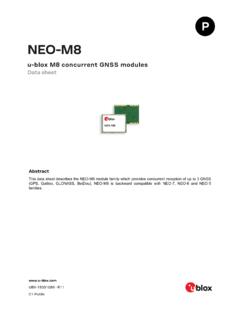Transcription of Guideline for Control Surveys by GNSS Special Publication 1
1 Guideline for Control Surveys by gnss Special Publication 1 Version Intergovernmental Committee on Surveying and Mapping (ICSM) Permanent Committee on Geodesy (PCG) 24 September 2014 Intergovernmental Committee on Surveying and Mapping Guideline for Control Surveys by gnss SP1 ii Version Document History DATE VERS ISSUE AMENDMENTS AUTHOR(S) 24/10/2013 2 0 Document available ICSM Permanent Committee on Geodesy 24/09/2014 2 1 Inclusion of real-time gnss Surveys , copyright updated ICSM Permanent Committee on Geodesy Commonwealth of Australia (ICSM) 2014 With the exception of the ICSM logo and where otherwise noted, all material in this Publication is provided under a Creative Commons Attribution Australia Licence ( ) Intergovernmental Committee on Surveying and Mapping Guideline for Control Surveys by gnss SP1 iii Version Table of contents Document History .. ii Table of contents.
2 Iii List of tables .. iv List of figures .. iv Terms and definitions .. v 1 About this Guideline .. 1 Introduction .. 1 Normative References .. 2 2 Connection to datum .. 3 Datum transformations .. 3 AHD height 3 3 gnss survey guidelines .. 5 General considerations .. 5 Static Surveys .. 6 Real-time Surveys .. 7 gnss equipment and observation techniques .. 7 Static Surveys .. 7 Real-time Surveys .. 8 gnss processing procedures .. 10 Static Surveys .. 10 Real-time Surveys .. 10 4 Uncertainty of gnss Surveys .. 11 Classifying AHD heights derived from gnss and AUSG eoid .. 11 5 Evaluation of real-time gnss Surveys using coordinate comparison .. 12 6 AUSPOS online GPS processing service .. 16 Intergovernmental Committee on Surveying and Mapping Guideline for Control Surveys by gnss SP1 iv Version List of tables Table 1: gnss observation techniques for Classic Static and Quick Static Surveys to achieve nominated levels of survey uncertainty.
3 7 Table 2: gnss equipment and observation techniques for real-time Surveys .. 8 Table 3: Minimum gnss processing software recommendations for Classic Static and Quick Static Surveys .. 10 List of figures Figure 1: Relationship between the ellipsoid, geoid, AHD and the topography .. 4 Figure 2: gnss survey techniques .. 5 Figure 3: Example network of marks to be coordinated .. 13 Intergovernmental Committee on Surveying and Mapping Guideline for Control Surveys by gnss SP1 v Version Terms and definitions For the purpose of this Guideline , the terms and definitions listed below and those listed in the Standard for the Australian Survey Control Network Special Publication 1, Version apply. Term/Acronym Definition Elevation mask A gnss receiver setting that determines whether gnss signals are recorded below a certain angle above the horizon. IGS International gnss Service - An international federation of agencies that pool resources to operate a global CORS network whose data is used, amongst other purposes, to generate precise gnss products in support of Earth science research.
4 Multipath Errors in gnss observations caused by reflected gnss signals interfering with the direct gnss signal due to their common time origin but different path lengths. Network Real-time Kinematic (NRTK) A technique which produces real-time corrections from a network of CORS, to reduce the uncertainty in the position of the rover. NGS National Geodetic Survey United States of America national mapping agency. Real-time Kinematic (RTK) A technique which uses real-time corrections from reference stations, either as a temporary setup or as a CORS, to reduce the uncertainty in the position of the rover. Redundancy A least squares solution is said to contain redundancy if the total number of measurements exceeds the minimum number required to compute the unknown parameters. RINEX receiver INdependent EXchange An internationally accepted format for the exchange of gnss data between software applications and for gnss data archiving.
5 Intergovernmental Committee on Surveying and Mapping Guideline for Control Surveys by gnss SP1 1 Version 1 About this Guideline Introduction The availability of accurate and reliable information relating to the position and uncertainty of Australia s survey Control marks is critical to the integrity of the National Geospatial Reference System (NGRS). The purpose of this Guideline is to promote the adoption of uniform Global Navigation Satellite System ( gnss ) surveying procedures to achieve the highest level of rigour and integrity in Australia s survey Control mark network. gnss surveying involves the collection of precise code and carrier phase measurements recorded simultaneously at two or more survey Control marks using high precision gnss equipment and/or Continuously Operating Reference Stations (CORS). Those measurements can then be processed to derive gnss baselines from which the 3D position and uncertainty for each survey Control mark can be estimated.
6 The processing of the gnss measurements can be done in real-time in the field or after completion of the field measurements in so-called post-processing. gnss based Surveys can vary in quality, depending on the type of gnss receiver , antenna, ancillary equipment and observation parameters chosen. All have a direct influence on the uncertainty of derived gnss measurements. Similarly, variation in measurement uncertainty will result from the spatial extent of the survey, the presence of certain external influences and the environmental conditions under which the Control survey is undertaken. The uncertainty of derived coordinates is directly related to the technique chosen for a gnss survey. There may also be additional measurement and processing techniques not covered in this Guideline that may be judged by a surveyor to be suitable for particular types of General Purpose Control Surveys .
7 However, those additional techniques including Precise Point Positioning (PPP), code-based Differential gnss and Single Point Positioning are not suitable for Datum Control Surveys and are beyond the scope of this Guideline . It is recognised that with the current momentum of development in gnss technology, gnss equipment, software and processing algorithms will continue to improve and as such this Guideline will face ongoing revision. This Guideline outlines ICSM s recommended equipment and procedures for gnss surveying. Intergovernmental Committee on Surveying and Mapping Guideline for Control Surveys by gnss SP1 2 Version Normative References This Guideline should be read in conjunction with the Standard for the Australian Survey Control Network Special Publication 1, Version herein referred to as the Standard. The following documents may have relevance to the application of this Guideline .
8 International Guidelines JCGM 100:2008, Evaluation of Measurement Data Guide to the Expression of Uncertainty in Measurement, Joint Committee for Guides in Metrology Bureau International des Poids et Mesures, Paris, France. SP1 Standard ICSM (2014), Standard for the Australian Survey Control Network Special Publication 1, Version , Intergovernmental Committee on Surveying and Mapping, Canberra, Australia. SP1 Guidelines ICSM (2014), Guideline for the Adjustment and Evaluation of Survey Control , Version , Intergovernmental Committee on Surveying and Mapping, Canberra, Australia. ICSM (2014), Guideline for Control Surveys by Differential Levelling, Version , Intergovernmental Committee on Surveying and Mapping, Canberra, Australia. ICSM (2014), Guideline for the Installation and Documentation of Survey Control Marks, Version , Intergovernmental Committee on Surveying and Mapping, Canberra, Australia.
9 ICSM (2014), Guideline for Continuously Operating Reference Stations, Version , Intergovernmental Committee on Surveying and Mapping, Canberra, Australia. ICSM Technical Manuals ICSM (2006), Geocentric Datum of Australia Technical Manual, Intergovernmental Committee on Surveying and Mapping, Canberra, Australia. ICSM (2007), Australian Tides Manual Special Publication 9, Intergovernmental Committee on Surveying and Mapping, Wollongong, Australia. Technical Publications Dawson, J. and Woods, A. (2010), ITRF to GDA94 coordinate transformations, Journal of Applied Geodesy, 4:4, pp. 189 199. Brown, N. J., Featherstone, W. E., Hu, G. and Johnston, G. (2011), AUSG eoid09: A more direct and more accurate model for converting ellipsoidal heights to AHD heights, Journal of Spatial Science, 56:1, pp. 27 37. Intergovernmental Committee on Surveying and Mapping Guideline for Control Surveys by gnss SP1 3 Version 2 Connection to datum Survey Control marks established for Australia s NGRS shall be coordinated relative to the datums set out in Section 2 of the Standard.
10 Datum transformations As outlined in the Standard, GDA94 is a static coordinate datum based on the International Terrestrial Reference Frame (ITRF) 1992, held fixed at the reference epoch of 1 January 1994. Users typically access gnss reference frames by processing their gnss measurements relative to: the Broadcast Ephemerides of the relevant gnss ; or a suitable IGS Precise Ephemerides product. In the case of Broadcast Ephemerides, the official reference frames for all gnss are closely aligned to a version of ITRF. However, there may be differences between the ITRF realisation and reference epoch used for a given gnss compared to those used for GDA94. By 2010, for example, the horizontal difference between GDA94 and WGS84 (as used for the GPS Broadcast Ephemerides) had exceeded one metre. In the case of Precise Ephemerides, IGS uses the most modern ITRF realisation and the current week for the reference epoch.









